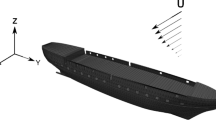Abstract
Deep-water shipwrecks and associated debris often sit on the bottom with relatively little disturbance, except for the natural bio-chemical deterioration. The distribution of shipwreck material can often be calculated mathematically as a function of heading, speed, time, and water depth. The Equation of Site Distribution is a method aimed to better understand deep-water site formation and the wrecking events themselves. With the use of a few relatively simple formulas, key elements of a site can be discovered, as well as greater insight of the overall wrecking event achieved.








Similar content being viewed by others
References
Best AI, Powrie W, Hayward T, Barton M (2000) Geotechnical investigation of the Titanic wreck site. Mar Georesour Geotechnol 18(4):315–331
Brooks JM, Fisher C, Roberts H, Bernard B, Cordes E, Baums I, Bernard B, Church R, Etnoyer P, German C, Goehring E, McDonald I, Roberts H, Shank T, Warren D, Welsh S, Wolff G (2010) Deepwater program: exploration and research of northern Gulf of Mexico deepwater natural and artificial hard bottom habitats with emphasis on coral communities: reefs, rigs and wrecks—“Lophelia II”: interim report. U.S. Dept. of the Interior, Minerals Management Service, Gulf of Mexico OCS Region, New Orleans, LA. OCS Study MMS 2010-0xx. 135 pp
Browning RM (1996) U.S. merchant vessel war casualties of World War II. Naval Institute Press, Annapolis
Burch HA (1942) Summary of statements by survivors of the SS Gulf Penn, U.S. Tanker. Navy department, Office of the Chief of Naval Operations. 22 May
Church RA, Arnold WS (2013) Deep-water shipwreck site distribution: the equation of site formation. In: Presentation at the society for historical archaeology conference, Leicester, England, January
Church RA, DJ, Warren A, Hill W, Smith JS (2002) The discovery of U-166: rewriting history with new technology. In: Proceedings of the 2002 offshore technology conference. May
Church RA, Warren DJ (2002) Unraveling the mystery: the discovery of U-166. In: Proceedings of the information transfer meeting, New Orleans
Church R, Warren D, Cullimore R, Johnston L, Kilgour M, Moore J, Morris N, Patterson W, Schroeder W, Shirley T (2007) Archaeological and biological analysis of World War II shipwrecks in the Gulf of Mexico: artificial reef effect in deepwater. U.S. Dept. of the Interior, Minerals Management Service, New Orleans, LA. OCS Study MMS 2007-015
Church, R.A., D.J. Warren, and J.B. Irion. 2009. Analysis of deepwater shipwrecks in the Gulf of Mexico: artificial reef effect of six World War II Shipwrecks. Oceanography, Washington DC, Oceanography Society 22(2):50–63
Garzke W, Wood D, Cullimore R (1998) Anatomy of a disaster: TitaniCon, six hours of chat with the experts. 20 Dec, 1998. http://www.astralgia.com/webportfolio/omnimoment/titanic/conv/chat2.html
Garzke WH, Dulin RO, Brown DK, Prince K (2000) Marine forensics for naval architects and marine engineers. Naval Eng J 112:249–264
Henderson ED (1942) Summary of statements by survivors of the SS Robert E. Lee, U.S. Cargo-Passenger Vessel. Navy department, Office of the Chief of Naval Operations. 13 Aug
Machine (1971) How does a ship sink? Machine Design 43(27):39
Mott RL (1994) Applied fluid mechanics. Prentice Hall Career & Technology, Englewood Cliffs
USS PC-566 (1942) Logs of the USS PC-566, Attached to the gulf sea frontier, 7th Naval District, 30 July, 1942. National Archives and Records Administration, Washington DC
Warren DJ, Church RA (2004) Discovering H.M.S. Ark Royal. Hydro Int 8(7):28–30
Warren D, Church R, Cullimore R, Johnston L (2004) ROV Investigations of the DKM U-166 Shipwreck site to document the archaeological and biological aspects of the wreck site: final performance report. U.S. Department of Commerce, National Oceanic and Atmospheric Administration, Office of Ocean Exploration. Silver Spring, Maryland
Wiggins Melanie (1995) Torpedoes in the Gulf: Galveston and the U-Boats 1942–1943. Texas A&M University Press, College Station
Würdemann, Erich Kapitän Lt. (1942) Kriegstagebuch (KTB or War Diary) for German Submarine “U-506” (Patrol Duration: 26 March to 15 June 1942). Translated by James F. Trent. Birmingham, AL
Acknowledgments
The author thanks the companies and government agencies that sponsored the many geophysical surveys, ROV investigations, and archaeological studies that contributed to this work: C & C Technologies, Inc., BP Exploration, Shell International, TDI Brooks, Inc., Bureau of Ocean Energy Management (BOEM) formerly the MMS, the National Oceanographic Atmospheric National Oceanic and Atmospheric Administration’s Office of Ocean Exploration and Research (NOAA OER), and National Oceanographic Partnership Program (NOPP). The author also expresses his appreciation to Daniel Warren, Robert Westrick, Shawn Arnold, Tony George, and Keagan Gopaul for their contributions and input.
Author information
Authors and Affiliations
Corresponding author
Rights and permissions
About this article
Cite this article
Church, R.A. Deep-Water Shipwreck Initial Site Formation: The Equation of Site Distribution. J Mari Arch 9, 27–40 (2014). https://doi.org/10.1007/s11457-014-9128-6
Published:
Issue Date:
DOI: https://doi.org/10.1007/s11457-014-9128-6




